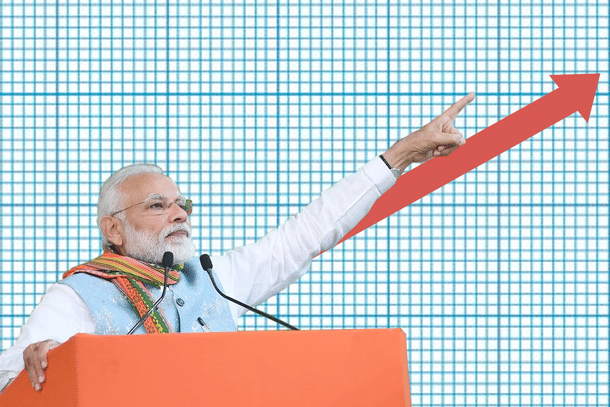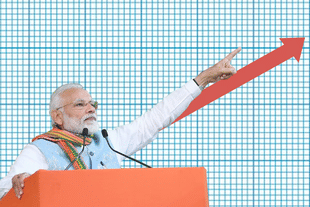Economy
Modinomics Wins: Private Sector Started Expanding Capacities
Pratim Ranjan Bose
Jun 04, 2023, 01:32 PM | Updated 02:17 PM IST
Save & read from anywhere!
Bookmark stories for easy access on any device or the Swarajya app.


Over the last nine years, the Narendra Modi government did a lot to improve the core economic efficiency and attract private investments.
Services were always India’s strong point. The challenge was to make it (services) future-ready and attract investment in manufacturing as well.
The fragmented indirect tax structure was replaced by a nationwide goods and services tax (GST); logistics efficiency improved drastically and more is being done; start-ups triggered an entrepreneurship rush etc. The strong leadership, particularly during Covid, added to India’s attractiveness.
Some of these yielded results. Except for the temporary setback in the lockdown-hit June 2020 quarter, India has been the fastest-growing economy among its peers for the majority of the period.
Annual inflow of foreign direct investment (FDI) increased three-fold. However, the overall private capital expenditure remained low. The huge over-capacity created in the core sector during the UPA-era boom and burst phase with collateral damages in the banking sector; came in the way of capacity expansion.
The latest round of economic data indicates, the puzzle is finally solved. The gross fixed capital formation (GFCF) has reached a nine-year high of 34 per cent of the real GDP (at 2011-12 prices) in 2022-23.
Private capex is rising, both in the manufacturing and services sectors. After nearly a decade, India is witnessing fresh investments in capacity augmentation. The mammoth capacity expansion drive by Air India and IndiGo, indicates what’s happening in services.
A similar trend is consolidating in manufacturing.
Add to that robust growth in agriculture, better-than-expected gross domestic product (GDP) growth, sustained rise in GST collection, 31-month high purchase managers index (PMI) for manufacturing in May, decent rise in mobile transactions etc — most economic indicators are on the right direction.
There are some concerns about tepid growth in household consumption and rural demand. However, it might be due to the inflationary impact in 2022-23.
With inflation cooled down to 4.7 percent in April, household consumption should pick up sooner than later.
Beginning Of A Boom?
Decisions to augment capacity are neither taken nor abandoned in a day. Things were improving steadily over the last two years when the Indian economy staged a dramatic recovery from the Covid shock, and Apple Inc started sourcing iPhone14 from India.
The trend has now gained momentum. Last week, Apple’s Taiwanese partner Foxconn Technology announced plans to invest in a new iPhone facility in Karnataka.
Apple is merely a symbol of renewed interest in Indian manufacturing.
On a granular scale, the forging industry offers better insights into the change in investment climate. The sector is witnessing a dramatic spike in demand over the last few months.
A top forging company in eastern India have its order books full for the next one and a half years. Smaller entities report a three times higher flow of orders.
Forging is an ancillary sector that caters to core industries which in turn feed a wide range of manufacturing and services sectors. The heightened activity in the sector, therefore, is indicative of a major investment rush across the industrial value chain.
Considering the huge growth in the service sector any uptick in manufacturing may indicate the beginning of a robust boom phase. Part of it is already visible.
Consumption of steel increased by a whopping 17 per cent in the March quarter. According to Nageswaran, the sector witnessed a 50 per cent rise in capex in 2022-23.
Steel is not alone; the entire metals portfolio is witnessing increased activity. Hotels saw an 80 per cent rise in capex. Textiles is witnessing rising investments, partly due to the production-linked incentive (PLI) scheme.
Cement and power were among the worst sufferers of the UPA-era boom and burst. Both ended up with huge overcapacity. Power and road infrastructure companies were top contributors to bad debt pile-up in banks and financial institutions.
The huge infra push by the government coupled with renewed demand from the real estate sector changed the context. Cement production grew by 8.6 per cent in 2022-23. The momentum will continue in 2023-24. Capacity utilization crossed 80 per cent.
In June 2022, India’s largest cement company Ultratech, announced 22.6 million tonne per annum (mtpa) capacity expansion by 2024-25. This is over and above, a previous plan to add 19.8 mtpa capacity expansion by 2022-23.
Over the last nine years, India’s installed power generation capacity increased by nearly 70 per cent, mostly through renewables, to 416 gigawatts (GW).
Coal-based capacity barely grew for the last six years. This is both due to renewable focus and high over-capacity in the coal-power segment. The plant load (PLF) of private producers was down to 45 per cent.
In 2022-23, private coal-power reported 61.8 per cent PLF. The last time it breached the 60 per cent mark was in 2012-13. The government has just announced plans to add 51GW new coal based capacity.
Coal production grew by 14.8 per cent last year. With private commercial mines coming onstream, fuel production will keep rising at a fast pace. To complete the core sector growth, cargo volume at major sea ports is growing by eight to nine percent a year.
Political Stability Is Key
During the last boom, capacity constraints in the core sector failed India. Coal-based power generation capacity grew but coal production didn’t.
Even the boiler-turbine-generator capacity suffered, leading to imports. Auto production increased but highways were not ready.
The situation is different this time. Not only has India doubled the highway network but, the quality of the new expressways is comparable to the best in the world.
The railway track quality is upgraded to increase speed. A new mode of transport is opened through rivers. Nationwide natural gas grid and electric mobility have widened energy choices.
Fast growth digital economy has increased market access potential to an unprecedented high — opening a sea of opportunities to the service sector.
This is a new India, with more robust fundamentals than ever and it is duly attracting the attention of investors both from abroad and in India. The only question is how much of it will translate into reality.
Political stability is key and Prime Minister Modi will be the single biggest factor between the cup and the lip. There is no alternative to him, even in the ruling BJP, leave alone the Opposition that’s a concoction of outdated political philosophies and failed leaders.




